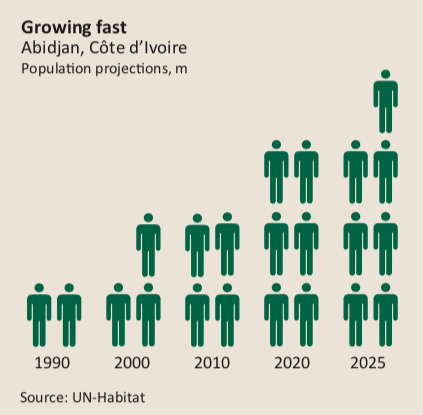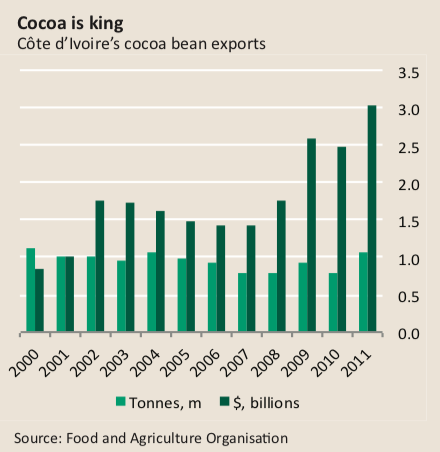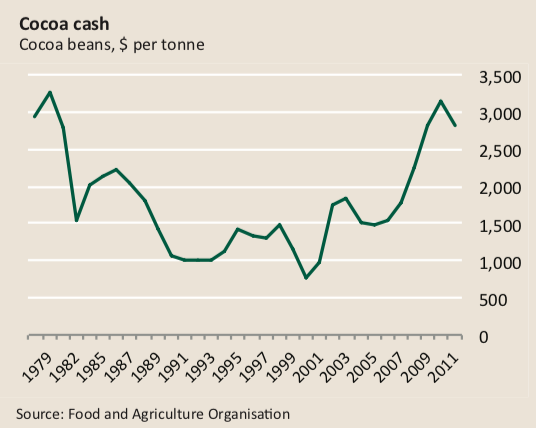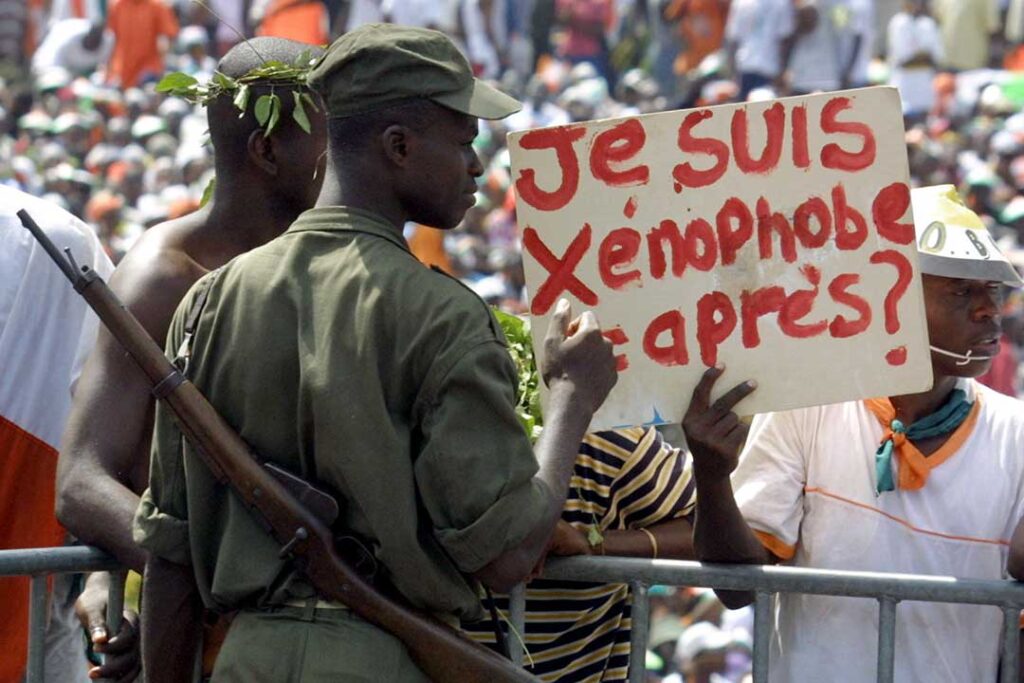The fall and rise of Abidjan
Côte d’Ivoire’s economic capital emerges from the shadow of war
Two years ago I was mugged on the street near Abidjan’s glimmering lagoon in the city centre. When I went to the police station to report the theft, I was taken aback when the officer on duty whispered to me, “Must have been a northerner. They’ve taken over.”
I have no idea where the thief was from. He was never caught. This xenophobic reaction, however, is indicative of simmering geographic and ethnic divides in Côte d’Ivoire’s largest city.
Abidjan, once known as the Paris of Africa, collapsed into conflict during the tumultuous 2000s, but is rebounding fast. The story of its ascent as one of west Africa’s primary hubs, its breakdown through a coup d’état and two civil wars, and its subsequent revival, can all be traced—at least in part—through the urbanisation of one of Africa’s most cosmopolitan cities.
Abidjan was not always such a bustling regional centre. Precise data are scarce, but some estimates suggestthat 50,000 people lived in Abidjan as recently as 1950, while others put the figure closer to 150,000, according to the University College London (UCL) Global Report on Human Settlements 2003. The government’s last official census in 2006 estimated that more than 5m people live in the metropolitan area. The population has likely expanded since this date.

Many countries in Africa saw rapid urban growth in the post-colonial period. Abidjan’s population explosion—and Côte d’Ivoire’s large-scale immigration in general—was different. It was done by design, carefully planned by one of Africa’s most masterful autocrats, President Félix Houphouët-Boigny.
Like many African countries, Côte d’Ivoire’s economy has relied on commodity exports such as cocoa, timber, palm oil, pineapples and coffee since independence in 1960. Côte d’Ivoire could be renamed the Cocoa Coast because cocoa is king.
Côte d’Ivoire overtook neighbouring Ghana in 1978 as the world’s leading producer and exporter of cocoa, according to a 2014 report from the Ghana Cocoa Board. This year Côte d’Ivoire is expected to account for 38% of the world’s cocoa production, yielding nearly double the quantity harvested by Ghana, its nearest competitor, according to the same report.
Part of this boom was driven by migrant labour, enticed by Mr Houphouët- Boigny. He realised presciently that a large influx of farm labour would create a surge in cocoa production, as Mike McGovern makes clear in his 2011 book “Making War in Côte d’Ivoire”. The president proclaimed a new principle: if individuals were willing and able to produce cocoa on vacant land, the plot would become theirs. People arrived in droves, from Burkina Faso, Ghana, Guinea, Liberia and Mali. Côte d’Ivoire became known as the “Ivori- an Miracle”, a testament to its booming economy driven by cocoa.

As migrant labour crossed Côte d’Ivoire’s porous borders, some Ivorians from the countryside moved to Abidjan, and some would- be migrant farmers by- passed a life in the fields for a life in the city. By 1978 only one in ten residents of Abidjan between the ages of 15 and 59 had been born there, according to the UCL study. They had moved past cocoa and into Cocody, one of Abidjan’s bustling and fast-growing neighbourhoods.
Rapid urbanisation can produce upheavals that are managed far more easily in prosperous times than in periods of crisis. Abidjan is a prime example: Mr Houphouët- Boigny, a master of political patronage, spread the wealth and kept the heat low on simmering tensions, thus ensuring that they did not boil over.
Prosperous times, which had started at independence, began to fade when cocoa prices declined in the 1980s. The melting pot started to boil over in the 1990s. A perfect storm of three jarring events turned the Ivorian miracle into the Ivorian nightmare.
First, the economy was in a long-standing slide in the early 1990s, brought about by a decline in cocoa prices—plunging from an average of $3,000 per metric tonne in the late 1970s to as low as $1,100 in the early 1990s, according to a 2007 IMF re- port. The well-lubricated system of political patronage did not work as well when the proverbial oil—cocoa profits—started to dry up.
Second, Mr Houphouët-Boigny died in December 1993. He was the lynchpin of a system that relied on his personal charisma and patronage relationships. When le Vieux (“the old man”), as he was affectionately known by Ivorians, died at the age of 88 after governing for 33 years, the system began to unravel as his would-be successors vied for power.
Third, multi-party democracy arrived at this critical point. While a worthy ideal, the political system’s opening to outright competition was poorly timed to coincide with economic free-fall, rising social tensions and a contentious succession battle.
These three developments heightened tensions throughout the country. Struggling cocoa farmers failing to make ends meet moved to the capital in search of new opportunities. Internal migration continued from the country- side to Abidjan.

During the era of the Ivorian miracle, tension in the capital ran low. With enough wealth to share, it mattered less who were the haves and who were the have-nots. But in the 1990s the economy contracted and political parties formed along geographic lines.
Successive presidents—starting with Henri Konan Bédié and continuing with Robert Guei and Laurent Gbagbo—sidelined the Rally of the Republicans (RDR) party, representing primarily the northern half of the country, including many migrant families that had come during the boom period.
This political exclusion, combined with the economic downturn and ethnic tensions partly fuelled by religious divides, eventually contributed to a complete transformation of a country and a city that had been the poster child of African development for decades. Between 1999 and 2011, the Paris of Africa would suffer through a coup d’état and two civil wars.
The most recent conflict erupted after the November 2010 presidential election. The RDR’s candidate, Alassane Ouattara, a northerner, defeated Mr Gbago, the incumbent and a southerner representing the Ivorian Popular Front (FPI) party. The FPI refused to accept defeat and conflict broke out shortly thereafter.
When I arrived in Abidjan for the first time in the summer of 2012, reminders of the conflict that had officially ended a year previously were everywhere. Bullet holes pockmarked the façades of some buildings and UN peacekeepers patrolled the streets.
During the 2011 civil war Abidjan demonstrated how urbanisation transforms cities on the continent into microcosms of national-level conflict. One of the working-class neighbourhoods in the economic capital, Yopougon, was home to some of the fiercest violence during this war, as Gbagbo and Ouattara militias fought each other. Geographic origins—and the associated characteristics of identity that they produce— do not disappear when people move from the country to the city.
Mr Ouattara’s militias, backed by the UN and the French military, won the war and the presidency. Mr Gbagbo was arrested and is now facing charges of crimes against humanity in the International Criminal Court in The Hague. The FPI was severely weakened.
Today Abidjan is re-emerging from these civil wars. Over the last two years, eco- nomic growth has averaged 9%, one of the world’s highest. To sustain the progress, how-
ever, Côte d’Ivoire will need to repeat what it did so well in the post-colonial period: harness diversity as an asset and ensure that governance can keep pace with demo- graphic growth.
Like much in Côte d’Ivoire, Abidjan is full of potential. The headquarters of the African Development Bank, which was relocated to Tunis as a result of the Ivorian conflict, is scheduled to return to the city this year. A long-overdue third bridge crossing the Abidjan lagoon, sorely needed to alleviate choking congestion, is finally back on track to be built by December.
But a city cannot be saved by major infrastructure projects and the return of financial services alone. Just as economic decline unravelled the Ivorian miracle in the 1990s and 2000s, Abidjan’s fragile resurgence could also be derailed again.
Water management may be one area to watch closely as a substantive indicator of whether Abidjan is truly back on track or simply good at putting on a show for the international community. The city is surrounded by water but has had problems delivering clean water to its residents. For the moment it appears that the government understands that sound public infrastructure fuels growth: it is making major investments in water and other vital foundations. Whether such investments will be sustained remains to be seen.
Once rocked by war and ethnic tensions, Abidjan is again rising. It is a microcosm of the country, a melting pot of divided neighbourhoods on the brink of reconciliation and revitalisation. Its experience underlines an important lesson about demographic flows in Africa: without proper management, urban migration can be a powder keg threatening to blow up even the most miraculous of African success stories.
Whether an Abidjan miracle can complement the Ivorian miracle is unknown. Its success hinges on making sure that all aspects of Côte d’Ivoire’s economic engine are repaired from the damage and disruption of war.




